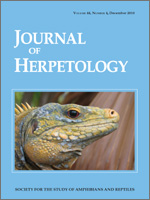The nominate subspecies of Slater's Skink, Egernia slateri, is nationally endangered with a severely restricted range on desert river floodplains in central Australia. Here, we provide the first details of foraging ecology and habitat use of one of the remaining wild populations. Ants (35.0% volume, 95.5% occurrence) and termites (Isoptera, 23.3% volume, 63.6% occurrence) were the major prey of adult E. slateri. Other important prey included Coleoptera, Orthoptera, and spiders. Egernia slateri depended on soil mounds formed at the base of shrubs as habitat in which to dig burrows. Ninety-five percent of shrubs in the genus Eremophila sampled in two subpopulations were mounded and 58% of the mounded shrubs had lizard burrows. Behavioral observations indicate that E. slateri is largely solitary with a group size of one (94% of bouts), except for three observations of adult–juvenile associations. Animals showed diurnal activity with basking individuals present up to 327 min postsunrise. The study reveals E. slateri as a species occurring in small populations in limited habitat. It faces imminent threats to its persistence as a result of high disturbance regimes on floodplains in central Australia and is considered one of Australia's most threatened reptiles.
BioOne.org will be down briefly for maintenance on 17 December 2024 between 18:00-22:00 Pacific Time US. We apologize for any inconvenience.
How to translate text using browser tools
1 December 2010
Foraging Ecology and Habitat Use of Slater's Skink (Egernia slateri): An Endangered Australian Desert Lizard
Chris R. Pavey,
Chris J. Burwell,
Catherine E. M. Nano
ACCESS THE FULL ARTICLE

Journal of Herpetology
Vol. 44 • No. 4
December 2010
Vol. 44 • No. 4
December 2010




